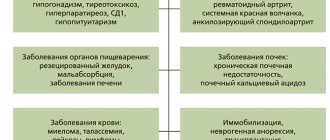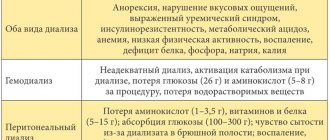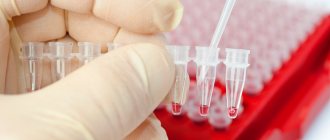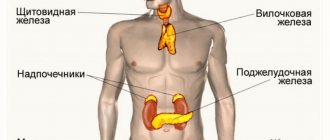General information
What is hypercalcemia? Hypercalcemia is defined as a systemic excess of total calcium in the blood serum, the concentration of which exceeds 10.4 mg/dL (> 2.60 mmol/L) or the concentration of ionized calcium in the blood serum exceeds 5.2 mg/dL (> 1.30 mmol/l). It should be understood that hypercalcemia is not an independent disease, but is a laboratory sign/metabolic symptom that is characteristic of various diseases/pathological conditions.
The role of calcium and the physiology of its metabolism in the human body
- Calcium is part of bone tissue and tooth enamel, ensuring the formation of mineral density of skeletal muscles and is involved in muscle function (providing, along with magnesium, the contractility of myocytes and normal contractions of muscle fibers).
- Participates directly in the exchange and metabolism of other elements, in particular phosphorus, is part of enzyme systems, intracellular ion channels are formed, through which tissue metabolites are then transported.
- Calcium ions are actively involved in the functioning of the coagulation system, as well as in the synthesis of hormonal substances and neurotransmitters, regulation of heart rate/conductivity.
Calcium is removed from the body through the kidneys, intestines and through sweating. Calcium metabolism is influenced by its intake from food, the ability of the digestive system to absorb it, as well as the functioning of the excretory organs (kidneys, intestines). The concentration of calcium in the blood is largely determined by the state of the function of the endocrine system (parathyroid glands and thyroid gland).
The human body contains approximately 1 kg of calcium, which is found in the form of hydroxyapatite mainly in the bones and in small quantities in the intracellular/extracellular fluid. Normal calcium intake is about 1 g of calcium per day for men aged 18-60 years and 1.2 g/day after 60 years. The daily calcium intake for females is determined taking into account not only the woman’s age, but also her reproductive status and is 1000 mg/day for women 18-60 years old; during pregnancy/lactation - approximately 1300-1400 mg/day; During menopause, the calcium norm is 1200 mg/day. An increase in calcium intake in people over 60 years of age is due to the risk of developing osteoporosis against the background of nutritional deficiency and negative age-related processes.
Typically, calcium homeostasis in the blood serum is maintained within normal limits, and the concentration of ionized calcium is regulated quite strictly by the action of parathyroid hormone , as well as 1,25- dihydroxyvitamin D on the bones, kidneys and gastrointestinal tract. Normal calcium levels are maintained by three mechanisms: absorption (absorption of calcium in the intestine), bone resorption (the process of destruction/degradation of bone tissue), which promotes the mobilization of calcium from the mineralized matrix, and the mechanism of reabsorption (reabsorption) of calcium in the renal tubules. Excess calcium in the body (pathological hypercalcemia) is a rather serious condition, a kind of marker, most often found in endocrine, renal and oncological pathologies.
According to statistics, in the general population of people, the incidence of hypercalcemia is 0.1-1.5%; and in samples of patients in hospitals, this proportion reaches 0.5-3.5%, which is facilitated by a complex of interrelated factors and reasons. According to the results of biochemical studies, the overwhelming number of cases of hypercalcemia (about 90%) is caused by pathology of the parathyroid glands (PTG) and oncological processes (malignant tumors of the lungs, kidneys, intestines, mammary glands, prostate in men and malignant diseases of the hematopoietic system).
The most common cause of hypercalcemia is primary hyperparathyroidism (PHPT), which is characterized by abnormally high activity of the parathyroid glands. In developed countries, PHPT is one of the main endocrinological diseases along with diabetes mellitus and thyroid diseases. At the same time, primary hyperparathyroidism occurs in women 3-4 times more often than in men, especially in the postmenopausal period (up to 3% of the population). The most significant hormone involved in the regulation of extracellular calcium is parathyroid hormone (parathyroid hormone).
Who is at risk?
The following are at risk of developing hyperparathyroidism:
- persons with long-term and severe vitamin D or calcium deficiency;
- women during their menopause;
- persons taking lithium preparations;
- persons suffering from rare hereditary diseases in which the activity of part of the endocrine glands is disrupted;
- patients undergoing radiation therapy.
The following are at risk of developing hypoparathyroidism:
- persons whose close relatives suffer from this disease;
- persons who have undergone certain surgical interventions in the neck area, especially removal of the thyroid gland;
- persons suffering from autoimmune diseases (with such diseases, cells of the immune system begin to destroy the structures of their own body);
- patients undergoing radiation therapy.
Pathogenesis
The pathogenesis of hypercalcemia and clinical manifestations is multifaceted. In this connection, we will briefly consider only the pathogenesis of hypercalcemia in primary hyperparathyroidism. It is based on a violation of the mechanism of suppression of parathyroid hormone (PTH) secretion. Excessive production of PTH causes a decrease in the renal threshold for reabsorption (re-absorption) of phosphates and in turn provokes the development of hyperphosphaturia / hypophosphatemia . Hyperphosphaturia and excessive production of PTH stimulate the synthesis of calcitriol 1,25-(0H)2-03 in the renal tubules, which helps to increase the absorption of calcium in the intestine.
Along with this, excess PTH leads to an acceleration of the processes of bone resorption and bone formation, but the process of formation of new bone tissue lags behind the process of its resorption, which ultimately leads to generalized osteoporosis / osteodystrophy and hypercalciuria , which contributes to the development of damage to the epithelium of the renal tubules and the gradual formation there are stones in them. The formation of various organ lesions is based on hypercalcemia , which causes the development of nephrocalcinosis / nephrolithiasis .
In the development of gastrointestinal lesions, in addition to hypercalcemia , accompanied by calcification / atherosclerosis of pepsin and hydrochloric acid is important . Excessive amounts of PTH, along with hypercalcemia, influence the development of pathological conditions of the cardiovascular system: left ventricular hypertrophy , arterial hypertension , myocardial , valvular , coronary calcifications , arrhythmias , increased contractility of the heart muscle. With chronic hypercalcemia, gradual deposition of calcifications can be observed in the muscles, kidneys, on the walls of large arteries, myocardium, and superficial layers of the cornea.
Vitamin D for calcium absorption. Fighting your own body
Probably, many of us have seen this picture in our lives: a young mother feeds her baby with a spoon, but he doesn’t eat, turns away, shakes his head. The mother uses all possible means to ensure that the child does not remain hungry: she shows him interesting toys, turns on cartoons, tells fairy tales, etc. and still shoves the ill-fated porridge or puree into her child.
One of the options for further developments is vomiting caused by excessive stomach fullness. After all, the child refused to open his mouth simply because he was already full.
Very often, after watching enough promising commercials, we act towards our body in exactly the same way as this mother. He refuses to absorb calcium, blocks its supply because the amount of the mineral in the blood is quite sufficient to ensure the normal functioning of all organs and tissues, and we force him to remove this blockage, we take vitamin D to absorb calcium. And yet we achieve our goal: the concentration of macronutrients in the blood increases. What's next? Naturally, we are waiting for our condition to improve.
But where are those strong bones and healthy teeth that the old ladies in the advertisements talked about? Bone and dental tissues became dense, but at the same time... fragile as glass. But the result is still the same - fractures, loss of teeth.
Classification
The classification is based on several characteristics.
Based on the content of the Ca+ cation, several degrees of severity of hypercalcemia are distinguished:
- Mild degree - total Ca content less than 3 mmol/l; ionized calcium – up to 1.5 mmol/l.
- Moderate degree - the level of total Ca is increased to 3.5 mmol/l; and the ionized calcium indicator is up to 1.8 mmol/l.
- Severe degree—total Ca level above 3.5 mmol/l; ionized calcium - more than 1.8 mmol/l.
According to the course, acute hypercalcemia (synonymous with hypercalcemic crisis) and chronic are distinguished.
A hyperparathyroid crisis occurs when excess calcium entering the bloodstream exceeds the excretory capacity of the kidneys. The critical calcium concentration is generally individual, but in most people the toxic effect appears already at levels of 3.4-4.1 mmol/l.
Calcium enters the blood only from the intestines. For this he has two ways.
The first is through the upper part of the small intestine (mainly the duodenum) with the help of vitamin D3, calcium-binding protein and amino acids (lysine and L-arginine).
The second is along the entire length of the small intestine without the participation of any substances (passively).
Our body is designed very wisely: it does not indiscriminately absorb all the calcium that we send into the gastrointestinal tract with food. How much of the macronutrient he retains for himself, and how much he excretes in urine and feces, depends on how rich the incoming food is in the mineral. When our diet contains low amounts of calcium-containing foods, the intestines absorb the mineral from food more efficiently, and the kidneys store it better. If food products are rich in calcium, the intestines stop absorbing it, and the kidneys begin to excrete the excess. This triggers protective functions, because an excess of calcium in the body is fraught with dire consequences. And the human body, unlike itself, knows this and strives to prevent a catastrophe.
Causes
The main causes of hypercalcemia include:
- Primary hyperparathyroidism , which is characterized by hypersecretion of parathyroid hormone and disruption of calcium homeostasis. It is caused mainly by hyperplasia of the parathyroid glands , adenoma , renal failure , and less often develops as part of polylinglandular autoimmune syndrome .
- Malignant neoplasms - multiple endocrine neoplasia types 1 and 2, isolated familial hyperparathyroidism , malignant diseases of the hematopoietic system, multiple myeloma , leukemia , breast , prostate , intestinal , lung , Hodgkin's lymphoma , Burkitt's lymphoma , squamous cell carcinoma , hypernephroma , etc.
- Granulomatous processes. They are represented by chronic diseases with the formation of cellular granulomas in various tissues (primarily in the lungs) - sarcoidosis , tuberculosis , histoplasmosis . Mononuclear phagocytes included in granulomas , through the mechanism of expression of 1-alpha hydroxylase, convert vitamin D into the active form (calcitrirol/1,25OH-D3), which leads to increased absorption of Ca+ ions by the small intestine.
- Taking medications (calcium supplements, vitamin D, lithium, thiazide diuretics, theophylline ) that can cause calcium imbalance through reabsorption processes in the tubules of the nephrons of the kidneys or increased osteodestruction.
- Dietary hypercalcemia syndrome. It is caused by a significant increase in the consumption of foods high in calcium or with excessive inclusion of milk or alkalis in the diet (milk-alkali syndrome - Burnett syndrome), which leads to the development of alkalosis, which in turn enhances the process of calcium reabsorption in the kidneys and leads to moderate/ severe hypercalcemia . Nutritional hypercalcemia syndrome can also occur with dyspepsia or with abnormal intake of calcium in the form of various nutritional supplements.
- Endocrine diseases - thyrotoxicosis , acromegaly , pheochromocytoma , hyper / hypocortisolism , excess prolactin / somatotropin .
- A state of prolonged, especially complete immobilization, due to orthopedic procedures (skeletal traction, cast), spinal injuries, neurological disorders, which after 1-3 weeks leads to hypercalcemia caused by accelerated resorption of bone matter. As a rule, calcium metabolism returns to normal after resuming physical activity.
- Benign familial hypocalciuric hypercalcemia . Refers to a hereditary autosomal dominant pathology caused by a mutation of calcium-sensitive receptors. It appears from birth and is clinically insignificant and mild in nature.
Calcium in nature is the most common substance on the planet
Having awarded calcium with such important powers, nature also made sure that our body did not lack it. Judge for yourself, calcium is one of the five most common substances on the planet . Before him are only oxygen, silicon, aluminum and iron. Calcium deposits in nature can be found in the form of chalk, limestone, and silica. The macroelement is part of most minerals (for example, marble, granite, alabaster, barite, spar, dolomite, gypsum, etc.). The products of its weathering (destruction) are always present in the soil and natural waters.
The average calcium content in the soil is 1.37%. Heavy clay soils are richer in it, and light soils are richer in it. The mineral forms and maintains the structure of the soil, balances the ratio of other elements in it, and promotes the decomposition of organic matter.
In river waters, up to 1 g of calcium is found in 1 liter. A large amount of it ends up in water bodies along with industrial and agricultural wastewater (when the latter uses calcium-containing mineral fertilizers).
The macronutrient is essential for all living organisms on the planet. Plants absorb it from soil and water. Lack of calcium inhibits seed germination, growth and development of the root system. In plants, the mineral can be found in the form of phosphates, sulfates, and carbonates. Animals obtain calcium by eating calcium-rich plants. In the organisms of vertebrates (and humans), the macroelement is contained in the form of phosphates, mostly in the skeleton and teeth; in the organisms of invertebrates (coral polyps, sponges, mollusks, etc.) - in the form of various forms of calcium carbonate in the skeleton.
A person obtains calcium by eating plants, animal meat, and water.
Symptoms
Hypercalcemia manifests itself with many symptoms that can be represented in several groups:
- systemic manifestations (dehydration, general muscle weakness, calcification of soft/other tissues and cornea);
- gastrointestinal function disorders (nausea, anorexia , vomiting, abdominal pain, constipation );
- neuropsychiatric symptoms (decreased concentration, emotional instability, depression , slight drowsiness , psychosis , confusion);
- pathology of the musculoskeletal system ( osteoporosis , fractures , hyperparathyroid osteodystrophy , proximal myopathy );
- disorders of the cardiovascular system (shortening of the QT interval, tachycardia , hypertension digitalis drugs );
- renal dysfunction (reduced glomerular filtration rate, polyuria , kidney stones , isosthenuria , nephrocalcinosis ).
The main manifestations of hypercalcemia are presented schematically below.
Symptoms of excess calcium in the body and the intensity of their manifestation vary significantly and depend on the severity of hypercalcemia (on the level of calcium cation concentration in the blood serum). In mild cases, symptoms of hypercalcemia may be completely absent for a long period, while with a sharp increase in calcium in the blood (hypercalcemic crisis), there is a sudden/sharp increase in almost all signs of hypercalcemia in the form of causeless weakness, nausea, decreased muscle tone, increased blood pressure, the appearance of joint/muscle pain.
As intoxication increases, pain appears in the epigastric region, a feeling of thirst, uncontrollable vomiting, constipation , frequent/copious urination, and appetite disappears. Due to dehydration, patients complain of headaches, dizziness, dry mouth, and itchy skin. After some time, the water-electrolyte imbalance is disrupted, polyuria is replaced by oliguria / anuria .
Neuropsychiatric disorders are represented by drowsiness , depression , psychasthenia , lethargy or increased excitability appears. Abdominal pain intensifies and is spastic in nature. DIC syndrome and intravascular thrombosis develop less frequently.
Signs of calcification
At the initial stages, it is extremely difficult to recognize the pathology due to its asymptomatic course. However, some types have a fairly pronounced clinical picture.
In case of systemic calcification or damage to the skin, joints, the epidermis becomes covered with small blisters, no changes in structure or color are observed. As the pathology progresses, calcium conglomerates grow and become denser to the touch and change color. Fistula formation is possible.
During routine examinations by specialists or during instrumental examination, lime deposits can be detected on teeth, bones, blood vessels, muscle and nerve fibers. The accumulation of macroelements on organ tissues leads to disruption of their functioning.
When the heart muscle and vascular system are damaged, the patient develops pain in the sternum, arm, neck, and back, which persists for a long time. Blood flow is also disrupted, which leads to surges in blood pressure and a feeling of coldness in the extremities.
When the kidneys are damaged, symptoms of intoxication increase, diuresis is disrupted, and the skin becomes dry and sluggish. When the organs of the digestive tract become calcified, their functioning is disrupted, which leads to nausea, vomiting, a feeling of heaviness in the abdominal area, and constipation.
When a large amount of calcium is damaged and accumulates in the brain, the patient experiences frequent attacks of headaches and dizziness, surges in intracranial pressure, impaired coordination of movement, memory impairment, problems with vision and hearing. As the disease progresses, fainting may occur.
At the same time, calcinosis leads to decreased performance, constant lethargy and fatigue, weakness, and loss of body weight.
Tests and diagnostics
Laboratory tests are prescribed: the levels of Ca2+, Mg2+, PO43 in the blood plasma, the concentration of Ca2+ in daily urine, the content of parathyroid hormone in plasma, the content of cAMP (cyclic adenosine monophosphate) in the urine. If necessary, a blood test for hormones (TSH, cortisol, free T4), determination of the level of 25(OH) vitamin D.
Instrumental studies:
- If hyperplasia/adenoma of the parathyroid glands is suspected, (computed tomography, ultrasound, scintigraphy) are prescribed.
- If there are symptoms of an inflammatory process/malignant neoplasm in various organs, a CT scan of the lungs, radiography, mammography, ultrasound of the abdominal organs, and ultrasound of the kidneys are prescribed.
- Densitometry is prescribed to determine bone mineral density.
Consequences of excess calcium in the body
— dehydration of connective tissue cells, their wilting and decreased physiological activity;
- development of urolithiasis (it has been proven that daily intake of calcium supplements increases the risk of stones in the kidneys and bladder by almost 2 times), renal colic (severe pain when stones move);
- increased fragility , fragility of bones (they collapse and break from any awkward fall) and blood vessels;
- decreased absorption of zinc by bone cells (this microelement is responsible for the proper formation and growth of bones and teeth);
— displacement of magnesium and sodium from their natural compounds;
- increased blood clotting (it becomes so thick that the heart has great difficulty pumping it, hence heart rhythm disturbances);
- narrowing of blood vessels, impaired tone of the vascular wall, slowing blood flow, increased thrombus formation (calcium is deposited in soft cholesterol plaques on the walls of large vessels, making them hard and blocking the movement of blood, like a mountain collapse blocks movement on a mountain road);
- heart attack and stroke (as a consequence of the previous two points);
- disturbance of acid-base balance, alkalization of the blood (calcium phosphate, which is formed during the pasteurization of cow's milk, has an alkaline reaction and is a practically insoluble compound), oxygen starvation (it is because of this that a person becomes irritable, he experiences twitching and muscle cramps) ;
- changes in the functional state of the central nervous system (the brain needs oxygen for normal functioning), excitability of the nervous system;
- milk-alkali syndrome (in other words, calcium-alkaline syndrome or Burnett's syndrome), the manifestations of which are nausea, vomiting, weakness, apathy, etc.
- disruption of the valvular apparatus of the heart due to loss of elasticity of the valves and the development of heart failure;
— dysfunction of muscle tissue.
Diet
There is no specially designed diet, however, in cases where an excess of calcium is caused by increased absorption of Ca+ in the intestine ( D-hypervitaminosis , Burnett's syndrome ), a diet with a decrease in calcium content in food is recommended (approximately at the level of 800 mg/day). For this purpose, it is recommended to limit the consumption of products such as sesame seeds, hard cheeses, almonds, sardines in oil, garlic, parsley, soybeans, hazelnuts, and also reduce the consumption of milk and dairy products.
Treatment
To treat calcification, a therapeutic course is prescribed that will help cope with the underlying disease. So, if inflammation of an infectious nature has led to excessive calcium deposition, antibacterial drugs are prescribed.
If calcium absorption is impaired, medications containing magnesium, which is a calcium antagonist, are prescribed. Sufficient intake of magnesium from food and medications allows you to dissolve conglomerates and remove excess calcium from the body. During treatment, it is important to take diuretics, which will help speed up the process of excretion of the macroelement.
Vitamin D takes part in the process of calcium absorption, the excess supply of which also negatively affects the condition of the body. Therefore, during treatment, it is necessary to follow a special diet that excludes the consumption of large quantities of foods rich in calcium and vitamin D. These include fatty fish, leafy greens, dairy products, egg yolk, and nuts.
If conservative treatment methods are ineffective, as well as the formation of large conglomerates, their surgical removal is prescribed. The choice of surgical intervention method is carried out depending on the size of calcium accumulations, as well as their location.
List of sources
- Leonard R. Sanders. Hyperparathyroidism // Secrets of endocrinology / ed. M.T McDermott. - M.-SPb: BINOM Publishing House - Nevsky Dialect, 2001. - P. 129-140.
- Dedov I.I., Melnichenko G.A., Pronin V.S., et al. Clinic and diagnosis of endocrine disorders. - M., 2005. - P. 99–111.
- Volkov M.M., Kayukov I.G., Smirnov A.V. phosphorus-calcium metabolism and its regulation. Nephrology. 2010; 14(1):91-103.
- Cherenko S.M. Primary hyperparathyroidism: basics of pathogenesis, diagnosis and surgical treatment. - K.: Express polygraph, 2011. - 148 p.
- Mirnaya S.S., Pigarova E.A., Belyaeva A.V. et al. The role of the calcium-sensing receptor in maintaining the calcium homeostasis system // Osteoporosis and Osteopathy. 2010. No. 3. pp. 32–36.
Calcinosis during pregnancy
Calcium deposition during pregnancy is most often diagnosed at the end of the third trimester of the gestational period. From a medical point of view, such a process is permissible and is associated with a modification of the placenta.
If calcification is diagnosed earlier, it can lead to premature maturation of the placenta. As a rule, calcinosis in pregnant women is associated with the consumption of large amounts of foods rich in calcium, infectious processes and metabolic disorders.
An excess of a macronutrient in a pregnant woman’s body is just as dangerous as its deficiency. May cause injury to the baby and mother during delivery.
Calcium for the prevention of osteoporosis
Millions of people today take vitamin D with calcium to prevent osteoporosis, strengthen bone tissue, and prevent fractures. According to surveys conducted in the United States, 56% of women over 60 years of age take vitamin D supplements and 60% take calcium supplements. These are accessible and inexpensive means. And, if you believe the advertising, they are also very effective. Many of those who purchase the treasured boxes and jars at the pharmacy do not even consult a doctor about the need to take them, being firmly convinced that there is no such thing as too much calcium, and that this is an absolutely safe food supplement.
Meanwhile, most recently, US scientists (A. Virginia Moyer et al.) - members of the US Preventative Services Task Force / USPSTF - conducted a meta-analysis (pooled analysis) of the results of 16 randomized controlled trials (participants are randomly assigned by groups - control and experimental) the effect of daily intake of vitamin D (more than 400 IU) in combination with calcium (more than 1000 mg) and without it on the condition of bone tissue in adults, on reducing the incidence of fractures in postmenopausal women (when the ovaries stop producing hormones ) and older men.
The largest proportion of study participants were postmenopausal women. On May 7, 2013, in the academic medical journal Annals of Internal Medicine, American independent experts in the field of medicine published their conclusions: “ Calcium in the doses that doctors recommend for patients with osteoporosis causes the formation of kidney stones and does not in any way contribute to the improvement of the patient’s condition . Excess calcium in the body provokes the formation of plaques in the blood vessels and impairs the supply of nutrients to tissues, including bones.”








